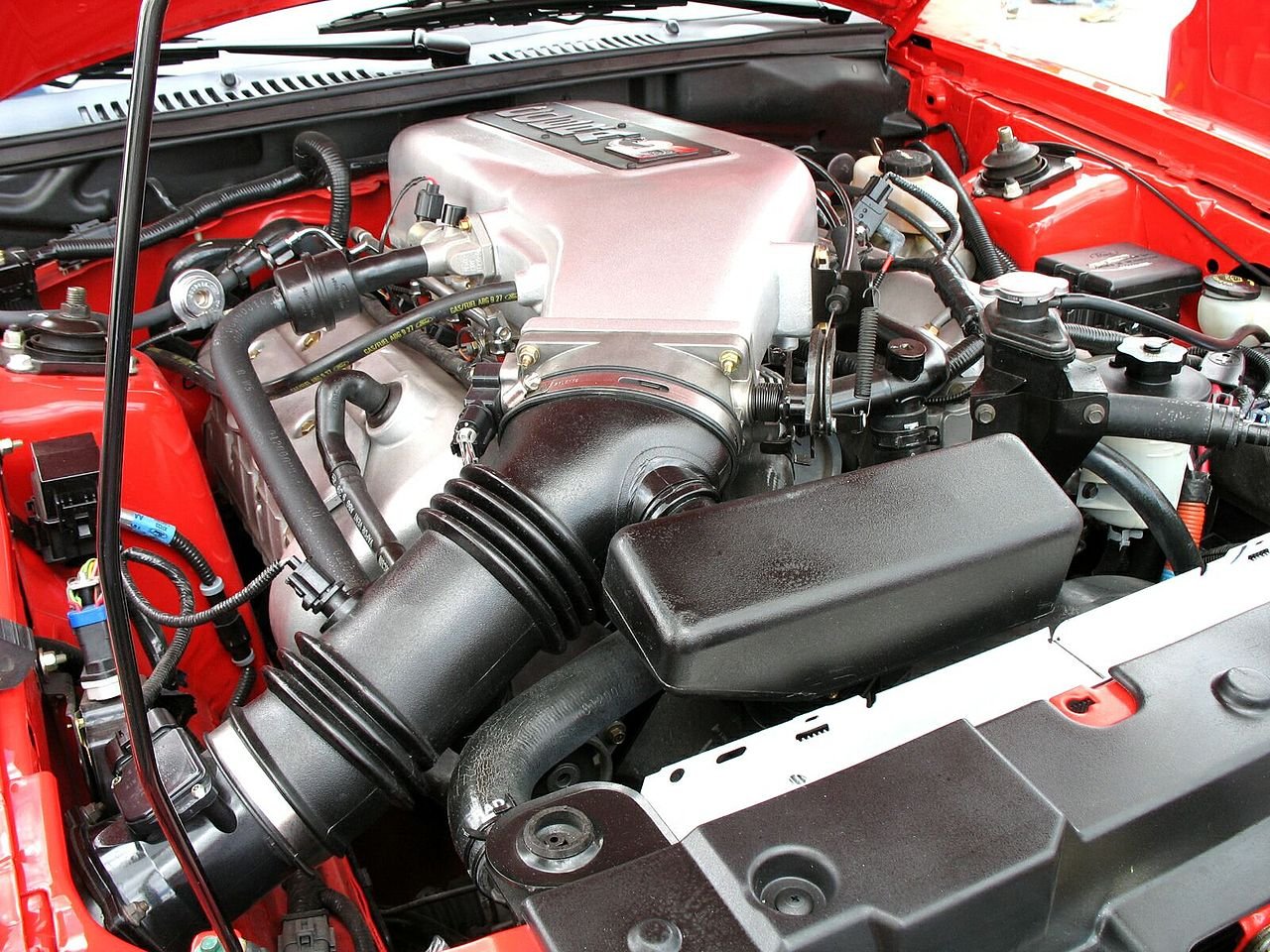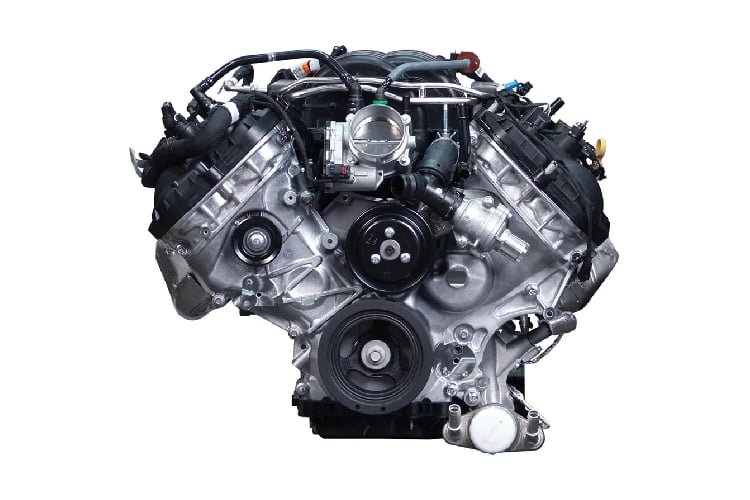Most people love the power, raw strength and thumping feel that they get from Ford cars, trucks, and SUVs. The 5.4L Triton, 4.6L V8, and 5.0L Coyote are three Ford engines that offer an almost unmatched driving experience.
The 4.6L engine is a naturally aspirated eight-cylinder machine. It was the foremost product in the Ford Modular engine family. Besides, the 5.4L and 5.0L are beasts, thanks to their towing capability, torque, and power rating.
In this article, I will examine the highlights of each engine and recommend the best option for you.
Ford 5.4L vs 4.6L vs 5.0L Engine: Specs Comparison
This table contains the main features of the 5.4L, 4.6L, and 5.0L. It provides an insight into the specifications, advantages, and potential problems of each engine
| 5.4L | 4.6L | 5.0L | |
| Firing order | 1-3-7-2-6-5-4-8 | 1-3-7-2-6-5-4-8 | 1-5-4-2-6-3-7-8 (VIN “N”) 1-3-7-2-6-5-4-8 (VIN “P) |
| Longevity | 300,000 miles | 300,000 miles | 300,000 miles |
| Max. Towing capacity | 13,000lbs | 12,000lbs | 11,500lbs |
| Torque | 323 – 355 lb-ft | 320 lb-ft @ 4000rpm | 400 lb-ft |
| Horsepower | 260HP | 292HP @ 5700rpm | 395HP |
| Engine oil capacity | 1997 – 2003: 6.0 qts (5.7L) 2004+: 7.0 qts (6.6L) | 6.0 qts (5.7L) | 2011-2017: 3.63” 7.7 qts (7.2L) 2018+: 8.85 qts (8.4L) |
| Oil change interval | 5,000 miles/ 10,000 km/ 6 months | 5,000 miles/ 10,000 km/ 6 months | 10,000 miles/ 15,000 km/ 12 months |
| Bore size | 3.55” (90.2mm) | 3.55” (90.2mm) | 2011-2017: 3.63” (92.2mm) 2018+: 3.66” (93.0mm) |
| Stroke size | 4.17” (105.8mm) | 3.54” (90.0mm) | 3.65” (92.7mm) |
| Number of cylinders | 8 | 8 | 8 |
Based on the features given in the table above, we will now examine each engine in full detail.
Ford 5.4L vs 4.6L vs 5.0L Engine: Comparison Details
Horsepower And Torque
Winner: 5.0L Coyote
The basic version of the 5.4L Triton engine is capable of producing a torque of 355 lb-ft and 260hp. It produces a better throttle response compared to the 4.6L and 5.0L. With the aid of supercharging and other accessories, it should be able to deliver 450 lb-ft and 380hp at 4750rpm. Moreover, the 4.6L can give out 292 hp at 5700rm and 320lbft at 4000rpm.
Of these three Ford machines, the 5.0 Coyote offers the best balance, low-end torque, and speed. It is also capable of delivering 400 lb-ft and 395 hp at 4250rpm.
Towing capacity
Winner: 5.4L engine

The Ford F-150 is one of the most popular trucks on the market, and it comes in several different engine variations. Each of these engines has a different towing capacity, so you’ll want to choose your new pickup truck based on your specific needs.
The 5.4L engine has the most power, with a towing capacity of up to 13,000 pounds. This engine is most common in the F-150 Lariat Super Crew and other high-end models as well as. On the other hand, the 4.6L engine has a lower towing capacity of 12,000 pounds and is found in the medium-priced Ford F-150 XLT Super Cab. Finally, the 5.0L engine has a towing capacity of 11,500 pounds and is available in both the F-150 XLT Super Cab and the F-150 Lariat Super Crew.
So, which engine should you choose for your new Ford truck? It all depends on how much weight you’ll be pulling and how much money you want to spend. If you require the most power or have a larger budget, go with the 5.4L engine. On condition that you don’t need quite as much power but still want a capable truck, try the 4.6L engine. If you’re on a tight budget but still need a decent towing capacity, opt for the 5.0L engine. Of course, no matter which engine you choose, you can’t go wrong with a new Ford F-150 truck.
Read more: Best Replacement Engine for 5.4 Triton
Longevity
Winner: A tie between the three engines.
The 5.4L, 4.6L, and 5.0L engines have approximately the same longevity that can go up to 300,000. For that reason, it is a bit difficult to single out the best in this category.
Moreover, the life expectancy for any engine depends on its usage and how well you maintain it. If you use your truck to carry heavy loads regularly, it won’t last long compared to a vehicle used for conventional commuting.
If you adhere to a serious and consistent maintenance schedule, these three engines will last long. First, you should replace all internal fluids and air filters regularly. Then, monitor your cooling system and always check for any leaks.
Firing order
The Ford 4.6L and 5.4L engines have the same firing order that is 1-3-7-2-6-5-4-8. Whereas, the 5.0L engine has two variations with regard to the firing sequence. They are the VIN (Vehicle Identification Number) “P” type and the VIN “N” type. The firing pattern of the 5.0L VIN “N” engine is 1-5-4-2-6-3-7-8 while that of the VIN “P” type is 1-3-7-2-6-5-4-8.
Reliability
Winner: 5.0L

Credit: ford.com
A 5.4L engine is a solid machine. However, it could develop problems with the spark plugs and ignition coils, timing chain issues, and failure of the fuel pump power module. With proper maintenance and checkups with a technician, you are still be able to reduce the occurrence of these issues.
Further, the Ford 4.6L engine was good enough to power many flagship Ford vehicles for over two decades. Through its years of production, Ford introduced a number of modifications to the 4.6L engine to address early flaws.
Therefore, the reliability issues associated with it vary from one vehicle model to another. Some are stable while others are prone to some failures.
The major problems with the 4.6L include overheating due to poorly designed intake manifold, bad engine oil pressure, and engine misfires due to underlying problems. As a result, the 4.6L engine performs a little bit above average in terms of reliability.
Among these three engines, the 5.0 Coyote is the most reliable option. Meanwhile, the major challenges you could experience include a metallic ticking sound when the engine crosses 100,000 miles and slow gear shifts (with an automatic transmission).
Benefits And Drawbacks
5.4L Engine
Pros
- Large engine displacement and high power output.
- Good for towing heavy objects.
Cons
- Spark plug problems
- Average fuel economy
4.6L Engine
Pros
- Good fuel consumption rate
- Cost-effective compared to the 5.4L and 5.0L.
Cons
- Produces less torque at low rpm
- Low displacement and power due to weak stock rods.
5.0L Engine
Pros
- Large engine displacement and high power output
Cons
- More frequent maintenance is needed.
Read more: 2.7L EcoBoost Vs. 3.5L EcoBoost Vs. 5.0L
Which Car Models Have These Engines?
Many Flagship Ford vehicles have used the 4.6L, 5.0L, and 5.4L engines. Then, I will list out all the models and duration of use below.
5.4L Triton engine
| Ford Falcon (2002-2010) |
| Ford E-Series (1997-2017) |
| Ford Expedition (1997-2014) |
| Ford Mustang (2000-2012) |
| Ford GT (2004-2006) |
| Ford F-150 (1997-2010) |
5.0L Coyote engine
| Ford F-150 (2011 – present) |
| Ford Mustang ()2011-present) |
4.6L Engine
| 2-valve 4.6L engine | 3-valve 4.6L engine | 4-valve 4.6L |
| Ford Mustang GT (1996-2004) | Ford Mustang GT (2005-2010) | Ford Mustang SVT Cobra (1996-2004) |
| Ford Expedition (1997-2004) | Ford Explorer (2006-2010) | Ford Mustang Mach 1 (2003-2004) |
| Ford Thunderbird (1994-1997) | Ford F-150 (2008-2010) | |
| Ford E-Series (1997-2014) | Ford Mustang Bullitt (2008-2009) | |
| Ford Explorer (2002-2005) | ||
| Ford Crown Victoria (1992-2012) | ||
| Ford F-150 (1997-2010) |
Which Is The Best One?
Ford 5.4L Triton Vs. 4.6L
The 5.4L engine is typically more powerful than the 4.6L engine. It also has a longer lifespan and is more fuel-efficient. However, the 4.6L engine is more compact and easier to maintain. Therefore, which one is the better option really depends on what you are looking for in your vehicle.
If you want a powerful engine that can get you where you need to go quickly, then the 5.4L engine is probably a better choice for you. However, if you are looking for an engine that is easier to maintain and doesn’t require as much fuel, then the 4.6L engine might be a better option. Ultimately, the decision between the 5.4L and 4.6L engines is up to you and what you are looking for in your vehicle.
At the end of the day, both engines have their advantages and disadvantages. So, you will need to weigh the factors carefully when choosing between the 5.4L and 4.6L engine options for your Ford vehicle.
Ford 5.0L Coyote Vs. 5.4L Triton
The Ford 5.4L triton and the 5.0L coyote are both powerful engines that offer excellent performance on the road. Both engines feature a eight-cylinder design, with the difference being that the Ford 5.4L triton has a traditional iron block whereas the Ford 5.0L coyote has an aluminum block for a more lightweight and efficient design. The Ford 5.4L triton offers a displacement of 330ci and an output of 300hp, whereas the Ford 5.0L coyote has a displacement of 302 ci with an output of 360 hp.
Both engines offer excellent performance, with the Ford 5.4L triton being slightly more powerful and the Ford 5.0L coyote being more efficient. When choosing between the two, it really comes down to personal preference and what you value most in an engine. If you’re looking for sheer power, then the Ford 5.4L triton is the better option. However, if you’re looking for an engine that’s more fuel-efficient and lightweight, the Ford 5.0L coyote is a better choice. Finally, both engines are excellent choices for drivers looking for powerful performance on the road.
Ford 5.0L Coyote Vs. 4.6L
When it comes to choosing a V8 engine for your Ford vehicle, you have two main options – the 5.0L Coyote or the 4.6L. Both engines offer plenty of power and performance, but there are some key differences between them that you’ll want to take into account before making your final decision.
The 5.0L Coyote was first introduced in the 2011 Mustang GT. It replaced the 4.6L that was previously used in the Mustang. The Coyote engine has more horsepower and torque than the 4.6L, and it is also more fuel efficient.
Additionally, the main difference between the 5.0L Coyote and 4.6L engines is their displacement – the amount of space that each engine takes up within the engine bay. The 5.0L Coyote has a larger displacement than its counterpart, coming in at roughly 4950cc compared to the 4.6L’s 4605cc. This extra displacement results in the Coyote having a higher power output than the 4.6L, with peak power coming in at around 412 horsepower and 390 lb-ft of torque. The 4.6L, on the other hand, is rated at just over 300 horsepower and 320 lb-ft.
The 4.6L, however, has a slightly better fuel economy rating than the Coyote engine. Both engines are reliable and powerful and have been used in many other vehicles besides the Mustang GT. So, which one do you prefer: The 5.0L Coyote engine or the 4.6L?
Read more: Dodge 6.4 Hemi vs. 5.7 Hemi vs. 5.9 Magnum
Helpful resources:
